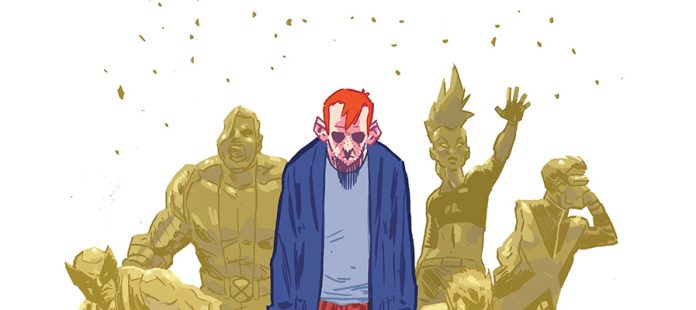Check out Our Review [WITH SPOILERS] of X-Men: Worst X-Man Ever #5!
Aside from the excitement in DC Comics’ Rebirth and Marvel’s own Civil War II, intrigue is no stranger to the Worst X-Man Ever mini-series. Written by Max Bemis, the singer for Say Anything, the series has taken a satirical look at both the X-Men, pop culture, and comics in general. As an outsider looking in, Bemis has broken convention.
Each week the story has become stranger with the addition of Bemis’ brilliant sense of humor. This week, in the last issue of the series, nothing has changed. Although, Bemis has taken his usual satirical approach much further. As for the quality, The Source proudly presents our final review of the series: Worst X-Man Ever #5 Reviewed.
The finale begins in a dystopian future. Our hero and the titular character, Bailey Hoskins, appears to be at least forty-five-years-old, possibly older. Lamenting, Bailey recounts the inevitable end of the X-Men. He ultimately concludes that an apocalypse is the only possible ending for the X-Men. In this case, the end of all was brought on by Bailey’s childhood nemesis and former teammate, Riches, who killed Professor Xavier.
In response to this, Bailey has become a bitter old man, crazy old Mr. Hoskins. He hates everything and everyone. He hates what the world has become, and he hates himself for being a part of it.
Suddenly, everything appears to be moving toward a meaningful climax when Bailey receives an invitation to The Annual Golden Ball celebrating Lord Riches Day. Reluctantly, Bailey agrees to go, hoping for the best. But, in typical Hoskins fashion, he walks into the party and there is a disaster. Not a sentinel attack or a Phoenix Force return, but a disaster nonetheless. Bailey’s childhood crush, Rags, is now living happily with Gambit. GAMBIT, the undeniably suave, sexy, French-sounding X-Man, has settled down with Bailey’s dream girl. However, Bailey seems happy for them, genuinely happy. Perhaps he has finally accepted his lot in life.
The Twist:
Despite his peace, Bailey is on the edge of uncontrollable rage. After spending some time at the “losers” table of mutants, Bailey runs into Miranda, his spunky, reality-changing friend from years ago. Together, they mourn the loss of the world thanks to Riches’ mutant dystopia. Eventually, Bailey laments that Miranda could have saved the world hundreds of times over if they let her unleash her full power. To his surprise, Miranda claims she did.
What follows is a potential explanation for why comics and their characters never age or die, and why the Marvel universe can be riddled with missteps. Miranda, a virtually unknown character in the Marvel universe, explains that she kept Tony Stark in his thirties for sixty years, revitalized heroes, and even brought Bucky back to life. This leaves the reader wondering, “Did Max Bemis really just create a character to make up for and explain comic book inconsistencies?” Yes, yes he did.
With that mind-blowing information rattling in his head, Bailey demands Miranda save the world, but she says she can’t. Despite her best efforts, she truly cannot. With nothing left to lose, Bailey finally decides to step-up and be the hero he always dreamed about. In a spectacular ball of flames, atop the Empire State Building, Bailey uses his cursed power to take out Riches once and for all.
The Meaning of It All:
In the following discourse, Miranda appears pleased, stating, “There’s your answer, Bailey. That’s what I was waiting for. I always knew you were the special one.” Throughout his life, Bailey felt like a loser or an outsider. He never truly fit in. All he wanted was to be special, to do something noble, something heroic. In the end, his sacrifice allowed for Miranda to warp reality again. Without it, she was powerless. One of the most powerful individuals in the Marvel universe was nothing without the worst X-Man ever, Bailey Hoskins.
It seems this was Max Bemis’ whole point. On the final page, readers see Bemis’ proposed idea in the form of a letter to Jordan D. White, one of Marvel’s many editors. Bemis introduces the idea of the Worst X-Man as someone who is an outsider in a world of outsiders, working against the descriptive, volatile concepts of “normal” and “rebel.”
Unfortunately, Jordan replies that the time for the Worst X-Man should be later on in the main book. However, since we finished the mini-series, we know that was not his only response. With that response and the crumbling panels from the page before, Bailey’s mini-series obviously occurs the way Bemis intends, but Miranda’s power and Bemis’ writing leave it open for Bailey Hoskins’ character to be explored again.
Bemis told us a wonderful, hilarious story, working against traditional social descriptors to show the reader that everyone can be special in their own way.
Sadly though, this is our final review of the series. We take solace in the fact that we loved every bittersweet second of it. Be sure to check our other reviews for the entire X-Men: Worst X-Man Ever series here-
Worst X-Men Ever #1
Worst X-Men Ever #2
Worst X-Men Ever #3
Worst X-Men Ever #4
For MORE reviews of comics, movies, and TV shows, you should probably work your way back here, to The Source.



loved this book. short but full of life and so refreshing for an xmen fan like myself
Comments are closed.